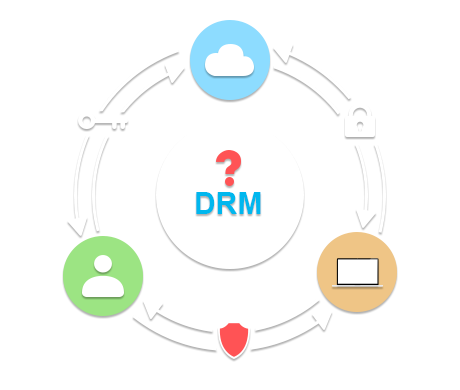DRM software builds a security barrier between content providers and users to ensure that content is protected from unauthorized access and theft during distribution and use. Digital content is protected by blocking editing, device binding, preventing sharing, dynamic digital watermarking, and preventing screen recording.
Digital rights management software is a complete encryption system used to protect digital content and files, prevent users from accessing without authorization from the content provider, and control access rights through license keys. DRM software builds a security barrier between content providers and users to ensure that content is protected from unauthorized access and theft during distribution and use. Digital content is protected by blocking editing, device binding, preventing sharing, dynamic digital watermarking, and preventing screen recording. DRM software takes a proactive approach to prevent illegal users from accessing protected digital content. In this way, the legitimate rights and interests of content creators and high-value digital assets are protected. It is usually used in industries such as online education, corporate training, internal corporate materials, and digital content consumption.
In the current interconnection, there are several powerful DRM software available in the market, all of them have their unique advantages and limitations. The following are some of the most widely used DRM encryption software, besides that, there are some other DRM software in the market, most of them use Google, Microsoft and Apple encryption system, such as: VdoCipher, JW Player and so on.
Google Widevine DRM
Widevine is one of the most widely used DRM technologies, known for its broad compatibility across platforms and devices. It is integrated into major browsers such as Chrome and Firefox, Android devices, and Chromecast to ensure broad audience reach. Widevine offers multiple levels of security, from software-based encryption to secure hardware execution environments, making it adaptable to diverse content protection needs.
Microsoft PlayReady DRM
PlayReady, developed by Microsoft, is another important DRM solution. It comes pre-installed on Windows devices and integrates seamlessly with the Microsoft ecosystem, including Xbox and Windows Phone. PlayReady supports offline playback capabilities, allowing users to download and view content without an Internet connection. However, its platform coverage is weak compared to Widevine.
Apple FairPlay DRM
Apple's FairPlay DRM dominates the Apple ecosystem. It provides security for content on iTunes, Apple TV and iOS devices. Its seamless integration and advanced security features make it ideal for protecting high-value content such as Hollywood movies. However, its compatibility is limited to Apple devices, which limits FairPlay's overall coverage, making FairPlay DRM a good choice if you only need to support the iOS ecosystem.
Haihaisoft DRM-X
DRM-X is a comprehensive DRM solution. It provides advanced protection, secure license key management, and flexible license controls to protect audio, video, PDFs, images, websites, JavaScript, and even Zoom sessions from unauthorized access and piracy. DRM-X supports a wide range of devices and systems, including Windows, Mac, iOS, and Android. With features such as dynamic watermarking, prevent screen recording (including protection against future recording software and browser-based online recording), and license revocation, DRM-X enables digital content creators and distributors to encrypt their high-value assets and confidently explore new monetization opportunities.
Among the leading DRM Software solutions, Widevine, PlayReady, FairPlay, and DRM-X stand out as popular choices, each offering unique features and capabilities. Based on our previous introduction to the best digital rights management (DRM) software, below we will compare these DRM software in terms of browser compatibility, player support, device adaptability, and functional features.
| DRM System | Browsers | Video Players | Devices | Features |
|---|---|---|---|---|
| Widevine DRM | Chrome, Firefox | VLC, JW Player, THEOplayer | Android, Chromebooks, Chromecast | Multi-level content protection, AES-128 encryption algorithm, playback limit, device binding, validity period control, watermark, anti-software screen recording (cannot prevent online screen recording) |
| PlayReady DRM | Edge | Windows Media Player, JW Player | Windows PCs, Xbox, Windows Phone | AES-128 and AES-256 encryption algorithms, rich APIs and SDKs, playback limit, device binding, validity period control, offline access, watermark, download prevention and software screen recording (cannot prevent online screen recording) |
| FairPlay DRM | Safari | QuickTime Player | Apple devices (Mac, iPhone, iPad, Apple TV) | AES-128 encryption algorithm, SDK provided, playback limit, device binding, validity period control, watermark, screen recording and screenshot prevention (valid for some devices) |
| DRM-X | Xvast (based on Chrome) | Most HTML5 Video Players (VideoJS and Plyr) | Windows, Mac, iOS, Android | High-strength private algorithm, AES-256 encryption, rich API integration interface, custom authorization authentication, number limit, device binding, validity period control, offline access, virtual machine disabled, dynamic watermark, prevent software screen recording and online screen recording |
Content encryption: digital content is encrypted by the DRM system before distribution, and the encrypted content cannot be played and opened directly.
License Management: Protected content is protected using license keys, and licenses are sent and managed by a dedicated license server.
License Rights Control: Restrictions on encrypted content through license rights, such as disallowing printing, count of prints, count of plays, license expiration date, Dynamic watermark, prevent screen recording, and prohibiting virtual machines.
User Authentication: When a user opens an encrypted file, a login authentication window will pop up and only authenticated users can open the encrypted file. The authentication rules can be verified by DRM user system or integrate DRM system with your user system, after integration, the authentication rules will be defined by you, for example, verify the user's IP, whether the user has purchased a particular course, etc.
Content decryption: After verification, the license server will send the license key to the current device, and the DRM client will use the key to decrypt the content, and the user can play or open the encrypted file normally.
Ask about Haihaisoft products, pricing, implementation, or anything else — our highly trained reps are standing by, ready to help.

